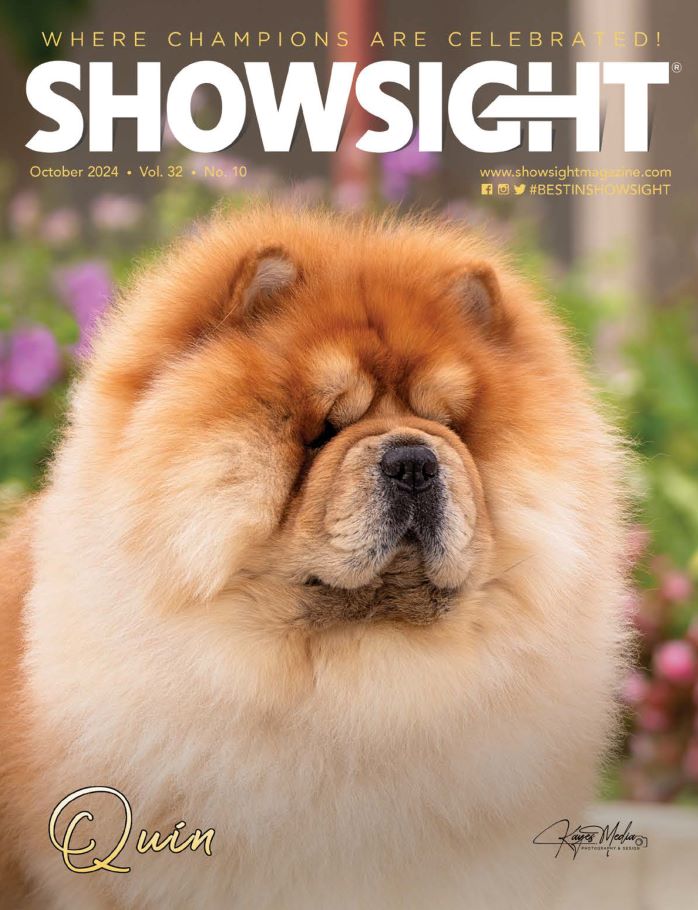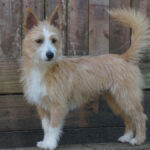This article was originally published in Showsight Magazine, May 2013 issue.
Saluki 101
“I could never own a dog I had to starve all the time.”
So said the lady with a Lab ringside. But I was ready. I whipped out my bait—not just your ho-hum liver, but a doggie-heaven vending machine assortment of meats and sweets—and offered them to my Saluki, who of course whipped her head away in disdain as I barely saved my fingers from her lunging Lab.
I explained most Saluki owners exchange recipes for Saluki-enticing entrees to which their dogs retch and threaten to be on slow-motion commercials for the HSUS. Most Salukis are thin because that’s how they naturally are.
Running
Runners are lean—and Salukis are runners. Not as fast as a Greyhound, nor as quick as a Whippet, the Saluki will leave the others behind after a quarter mile and—if in good running condition—will still be running hard at a mile. Even more important, at the end of the course they’ll return in good shape: no broken toes, torn ligaments, or blown pads. They specialize in rough terrain, their oversize feet acting like off-road tires.
Traditionally, Salukis coursed gazelle, rabbits, and other swift quarry both for sport and for the pot. Muslim religion considers dogs unclean, but makes an exception for the Saluki. Bedouin nomads invite the Saluki into their tent and treat them as prized possessions.
Middle Eastern Salukis are still used for coursing, but now they’re usually prevented from killing the gazelle. (Type in “Saluki” and “gazelle” on YouTube.com to see plenty of courses).
Salukis in the western United States course jackrabbits. Hunters walk vast fields until a jackrabbit bolts, then three Salukis are slipped once the jack has a head start. More often than not, the jack loses the dogs under a fence or in the dust after a long run. Salukis and non-AKC greyhounds dominate the sport. With little separation of show and field Saluki lines, BIS Salukis have earned the open field coursing titles.
Elsewhere, Salukis chase a lure to test their running ability, with both the original lure coursing body, the American Sighthound Field Association (ASFA) and the AKC award titles (ASFA FCh titles are listed as a suffix; AKC FC titles as a prefix).
Salukis are one of the more successful lure coursing breeds. They also compete in straight and oval racing.
At Home
Don’t fantasize that you can train your Saluki to ignore fleeing wildlife. Mine have caught deer, feral goats, and raccoons. But yes, they can live safely with a cat or small dog (just don’t let it out with a pack of Salukis and encourage it to run!).
They do not confuse small dogs at shows with prey; they are hunters, not fighters. They get along well with other dogs and usually all live loose together in multi-Saluki households.
Can you let a Saluki off lead? Yes, if he’s used to being off lead and if there’s no wildlife to chase or roads nearby, and you’re in no big hurry to get him back. Some people compare them to cats, but my cats actually came when called.
Salukis are calm and quiet housedogs, sleeping much of the day. Groups enjoy a couple of howl-alongs a day. Don’t even try to keep them off the softest and highest surfaces. “The Princess and the Pea” story was surely modeled after a Saluki.
Salukis attach deeply to one person or family. Most avoid public displays of affection, but are funny, loving, and snuggly in private. Their gentle nature makes them outstanding therapy dogs.

Health
As with other large dogs, hemangiosarcoma and dilated cardiomyopathy sometimes occur. Salukis should be prone to bloat, but it’s almost unheard of. Eye problems are even rarer (some sources list PRA as present, but that’s based on an erroneous report of a single dog in the 70s).
According to one source, Salukis have the highest incidence of extreme overbite (“parrot mouth”) of any breed, but it’s still rare.
Black hair follicular dysplasia is seen, but rarely. Average lifespan is 12 or 13 years; many live to their mid-teens.
In Competition
Salukis aren’t hop-to-it obedience dogs, but they’ll be the first in the class to learn the stay. The key to success in the obedience ring is to keep it challenging, keep it fast, keep it fun—and don’t practice!
Six Salukis have earned the UD title; none has come close to an OTCH! Nor has any Saluki earned a MACH, although several presently compete in Excellent.
They’re graceful jumpers, rarely knocking a bar, but tend to get the zoomies. Their stride makes tight courses difficult at speed, and the contact zones hard to hit as they’re much shorter than a single stride. They enjoy perching atop the A-frame—forever…
Most Salukis, including the four Westminster group-winning Salukis (Marjan, Cancer, Fantasia, and Treasure), are owner-handled. It’s an easy breed for beginners to show. You have to run, but you need not bait or heavily groom.
Neaten the underline, remove any fuzzy coat, bathe, brush the feathering (keep it untrimmed, even on the feet), and you’re done.
Some years ago, the top Junior in the country showed a Saluki. She said she chose the breed because it could be shown so many different ways (handler standing or kneeling, beside or in front, dog free stacked or hand stacked) and had just enough coat to fluff without constantly brushing.
Smooth & Feathered
Salukis come in smooth and feathered coats. The smooth coat (which results from one dominant gene) is close and short. Some may have a brush (not feathering) on the tail. A sparsely feathered Saluki is not a smooth.
Feathereds are longhaired dogs in which the non-feathered areas fail to grow long. The body coat is silky soft, with an undercoat. Guard hairs may be several inches long, but lay close to the body. This difference in body coat often gives the smooth, with its tighter coat, the illusion of being more defined and muscular. But get a feathered Saluki wet, and the difference disappears.
Feathered Saluki puppies often grow long fuzzy hair all over their body. The fuzz gradually disappears with maturity, with the last to go on the chest, thighs, elbows, and top of the head. This is normal and should not be faulted. Spayed and neutered feathered Salukis usually re-grow the longer body coat, often leaving only a short saddle. Keep this in mind when judging veteran classes at specialties! Again, it’s normal.
Judging
When judging the Saluki, you’re usually better off not talking. Many Salukis aren’t comfortable with strangers, and few have any desire to be your friend. Talking just makes it worse. And unless you come up with a truly original noise, the same old clucking sound is more likely to piss them off than to evoke a curious expression.
Don’t demand a Saluki to bait. Sure, baiting makes showing fun, but it should never be essential for Salukis.
Don’t expect cookie-cutters! Our standard is broad to include dogs that hunted different quarry (from rabbits to wild ass) over different terrain from a wide region of the Middle East. The height standard for males is 23 to 28 inches, and “bitches may be considerably smaller.” Most males in the ring hover around 27″ to 28″; most bitches are around 25″. You will never see a Saluki that’s too small. They were supposed to ride to the hunt on the backs of Arabian horses—not Clydesdales!
The standard mentions a wide range of colors: solids, sable (black-fringed), black & tan, and grizzle. Although neither parti-colors nor chocolates are mentioned, they’re equally accepted.
More controversial are the recent brindles, some of which come from Iranian imports, and others from a purportedly gypsy-bred dog by way of Australia. Some breeder-judges will excuse a brindle, whereas others will embrace it; in fact, an Australian-bred brindle won the National Specialty two years ago. With one of the oldest unchanged standards in the AKC, there’s little chance the SCOA membership will vote to open it to clarify colors.
Clubs & Rescue
The breed has two national clubs: The AKC parent club, the Saluki Club of America (SCOA), which holds the national specialty every year in Kentucky in June; and the open-to-all American Saluki Association (ASA), which holds its annual event every year at Lompoc in July.
The ASA was formed in the 1960s when the SCOA was largely inactive and unreceptive to new members. The ASA is still the largest source of Saluki information and activities, but the SCOA’s National has surpassed the ASA’s, and it has also become more open to new members (applying is now only slightly more intrusive than adopting a child).
The two clubs once had a slightly adversarial relationship, but now work together to create big Saluki weekends.
Rescue Salukis are uncommon but may be located through STOLA (www.stola.com). Other groups are importing rescues from the Middle East.
So that’s the Saluki: exotic and exasperating, snuggly and snobbish, known for its beauty but a hunter at heart. After 38 years with them, I still find something new to ponder every day.
I’ve watched in breathless awe as they skimmed over fields, and cursed in unprintable words as they kept on running into the distance. I’ve been filled with excitement watching them run the lure, and filled with dread watching them run a deer. And I’ve considered myself the luckiest masochist around as they steal my bed, snub my meals, and ransack my heart.










